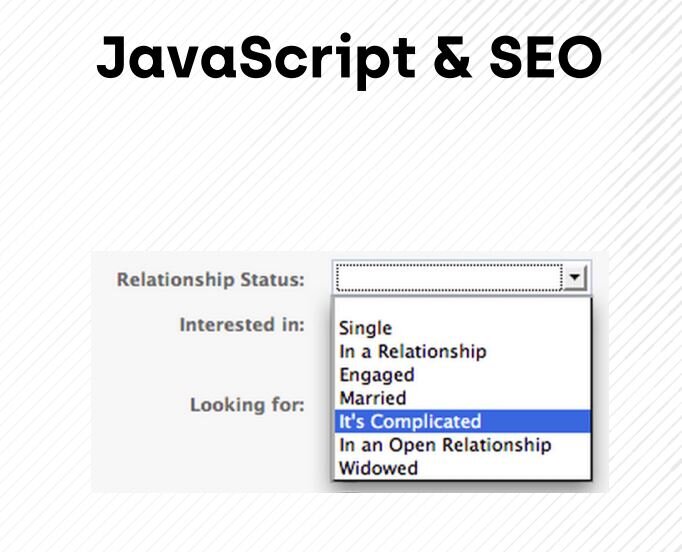JavaScript (JS) and SEO didn't always go well together. Search engine bots, such as the Googlebot, couldn't crawl JavaScript, so there not able to observe any content embedded with JavaScript. Today, Google and other search engines can crawl some JavaScript. In this blog, we reveal how it is possible to implement JavaScript to make sure that your SEO isn't affected.
What is JavaScript SEO?
JavaScript SEO is part of Technical SEO (Search Engine Optimization) that attempts to make JavaScript-heavy websites simple to crawl and index, so it is search engine friendly. The mission is to have those sites be found and rank high in search engines.
Is JavaScript awful for SEO, so is JavaScript bad? Not at all. It is only different from what many SEOs are used to, and there's a small learning curve. People do have a tendency to overuse it for things where there's probably a much better solution, but you must work with what you have sometimes. Just know that Javascript is not perfect and it is not always the right tool for the job. It can not be parsed progressively, unlike HTML and CSS, and it may be heavy on page loading and performance. Oftentimes, you may be trading performance for functionality.
Can Search Engines Crawl JavaScript?
In the USA, Google and Bing combined have a market share of over 90 percent. But, though they can crawl and render JavaScript, there's no guarantee they will.
Tests reveal that the amount of JavaScript crawled and rendered on various websites differs greatly. Using JavaScript is therefore always associated with a specific risk; that the crawlers do not crawl and index the material, meaning users will not find it in search engines. This should not scare you away from JavaScript, but from an SEO standpoint, there are numerous things that you need to keep an eye out for.
BING restricts the rendering capabilities of its own bots with regard to JavaScript and doesn't necessarily support all the same JavaScript frameworks supported in the most recent version of your browser. Therefore BING recommends utilizing dynamic rendering. Google also advises webmasters with fast-changing JavaScript articles to use lively rendering.
In the past search engines downloaded HTML responses which were enough to see the content of most pages. Thanks to the rise of JavaScript, search engines now need to render many pages as a browser would so they can see content how a user sees it.
The system that handles the rendering process at Google is called the Web Rendering Service (WRS). Google has provided a simplistic diagram to cover how this process works.
Can JavaScript Increase A Website's Loading Time?
JavaScript websites must first be rendered by a customer or a bot so they may be inspected. This rendering takes time. Consequently, JavaScript websites have a higher loading time compared to pure HTML sites, but with specific tools, loading times can be optimized even with JavaScript.
This guide shows in this informative article the way that JavaScript extends the loading time of cellular websites.
If JavaScript is used in the kind of a monitoring code third-party script, you should make it possible for the code to automatically load in the conclusion asynchronously so that the page speed is not affected.
How Does Google See JavaScript?
Google can render websites, including JavaScript and CSS. No significant site elements like those in JavaScript should be excluded from crawling.
Google has been able to read JavaScript and CSS since 2015 and advocated at the time that no important site elements, such as those in JavaScript or CSS are excluded from crawling via the robots.txt. Google also signaled that it prefers the principle of progressive enhancement, an approach involving the successive improvement of HTML websites. However, JavaScript would still be crawled and left.
In October 2018, at a response on Reddit, John Mueller pointed out that JavaScript would become more and more important in the coming years, and supplies SEOs the tip to focus more on JavaScript SEO: "If you are keen on specialized SEO, then past HTML you are likely to need to know JS increasingly more".
Why It Is Hard For Search Engines To Crawl JavaScript?
It's difficult for search engines to crawl JavaScript due to computing ability.
With JavaScript, this direct access is not feasible. The DOM's code is loaded and listed, and only when this is done can the site be left. Every browser does this automatically when browsing the net. This is a browser without a graphic user interface that is operated by means of a command line.
5 criteria for JavaScript and SEO
The articles must be indexable within the load occasion so that JavaScript articles is logical for search engines.
Content dependent on user events is not indexable.
JS websites need an indexable URL with server-side support.
The same SEO best practices used for HTML sites apply to producing JS websites.
There should be no contradiction between HTML and JavaScript versions of the website
Principles For The Growth Of JavaScript Websites.
JavaScript is much more complex than HTML. To realize what's important for SEO, you need to first attempt to understand how JavaScript functions:
1. Initial Request: The browser and the search engine bot start a GET request for the HTML code of the website and its affiliated assets.
2. DOM rendering: The JS script website provides the DOM (Document Object Model) to the browser or the bot. The document demonstrates how the content is going to be formed on the site and what the links are between the individual elements on the website. The browser renders this information and makes it visible and usable for the consumer.
3. IDOM load: While the target site is being processed, the browser triggers events that belong to the DOMContentLoaded. The first HTML document is subsequently loaded and stored. The bot is now ready to implement JavaScript components.
4. JavaScript implementation: JavaScript elements are now able to alter the contents or functions of this site with no HTML source code needing to be changed, eliminated, or expanded.
5. Load Event: As soon as the resources and the JS resources determined by these are loaded, the browser starts the load, and the site is finished.
6. Post Load Occasions: Following the JS website was loaded, further functional or content components can be changed or adapted by the user.
Search engines like Google use so-called headless browsers to be able to simulate entry to your conventional browser. In contrast to the"normal" browser, the browser calls up the code through the DOM to leave a website from it. In this manner, the Googlebot may, for instance, check which elements JavaScript inserts in order to modify the HTML site. After the rendering, the Googlebot may examine and index the left elements like an HTML source.
With JavaScript, you will find two variations for crawlers, the pre-DOM HTML code along with the left-handed post-DOM HTML code.
Significant Events From JavaScript That Have An Influence On SEO
Load events and user events can definitely affect your SEO. This is why:
Load Event: The loading event is"fired" by the browser when a site is completely loaded. Search engine robots mimic common browsers when making JavaScript. The loading event is therefore crucial to them - it makes it possible for them to have a snapshot of the rendered content. Events loaded following the loading event was fired will not be contemplated by JavaScript crawling, and so will not be indexed, since JavaScript can quickly change site content. This is especially the case for news sites or social networks feeds, such as Twitter and Facebook.
The time period of this DOMContentLoaded can be quantified with the Google development tool:
User Events: After the loading event, additional events can be triggered via JavaScript. Among these, as an example, are the so-called"onClick-Events." These are user-triggered occasions, such as the restriction of the website content or interactive navigation. But this content, which is created or altered by user occasions, is usually not indexed by search engines, because it takes place after the loading event.
Errors That You Ought To Avoid With JavaScript
If you use JavaScript on your site, Google can now leave the elements following the load event fairly well and may read and index the photo like a traditional HTML website.
These are a few of the most frequent mistakes that can occur:
1. Indexable URLs: Every site requires unique and distinctive URLs so the sites can be indexed in any way. A pushState, as is created with JavaScript, but does not generate a URL. Thus, your JavaScript website also requires its own web document that may give a status code 200 OK as a host answer to a customer or bot inquiry. Every product introduced with JS (or every category of your website realized with JS) should therefore be equipped with a server-side URL in order for your website can be indexed.
2. PushState mistakes: Together with the pushState method, JavaScript URLs could be altered. Therefore, you must absolutely make certain that the original URL is relayed with server-side support. Otherwise, you risk duplicate content.
3. Missing Metadata: With the use of JavaScript, lots of webmasters or SEO overlook the fundamentals and do not transfer meta information to the bot. On the other hand, the same search engine optimization standards hold for JavaScript content as for HTML sites.
4. A href and img src: The Googlebot requires links it can follow so that it may find further sites. Therefore, you also need to provide connections with href- or src-attributes in your JS documents.
5. Create unified variants: Through the manufacturing of JavaScript, preDOM and postDOM versions arise. Make sure that, if at all possible, no contradictions slip in and, for instance, that canonical tags or paginations can be correctly interpreted. In this manner, you'll avoid cloaking.
6. Make access for all bots: Not all bots can deal with JavaScript like the Googlebot. It's therefore recommended to place meta information and social tags in the HTML code.
7. Do not disable JS over robots.txt: Ensure that your JavaScript can even be crawled by the Googlebot. Because of this, the directories shouldn't be excluded in the robots.txt.
8. Utilize a present sitemap: In order to reveal Google any probable modifications in the JS contents, then you always need to maintain the attribute "lastmod" current in your XML sitemap.
Assess JavaScript Websites: What To Do An Audit
A JS site audit is mainly a manual inspection of individual components.
1. Visual inspection
To get a feel for the way the visitor will see a website, you need to divide the content on the website into:
Visible contents to the Website
Content that requires an interaction
Hidden content
Content that comes from third parties, such as evaluations
Content which includes product recommendations
This way, it is possible to narrow down the selection to components that can be realized with JavaScript. You should be checking the JavaScript components with the objective of making these elements crawlable.
2. Check HTML code
With web developer tools, you can turn off CSS, JavaScript, and cookies. You can discover what is missing on the site from the remaining code. These elements are controlled by JavaScript.
Then, you can control meta elements such as the title and website description. So that robots can index these components, they must be accessible via the load event. Generally, however, only Google can currently read these components. It's thus recommended to compose meta and title tags in the HTML code even with JS websites.
3. Check left HTML
At length, right-click on the website and select"Check element" in the Chrome menu. On the ideal side, another window will appear. Click on the HTML tag. Choose "Copy External HTML" here. Lastly, insert the code into an editor. This code can then be indexed by search engines like Google.
You can even test JavaScript with the Google Search Console with the URL review tool or the mobile-friendly evaluation instrument.
Further matters to think about
Indexable URLs: In order for a site to be indexed and rated at all, it requires an indexable URL. If your site uses versions of JavaScript that cannot be called up via their very own URL, it's not feasible for search engines to index this website. If a URL exists but cannot be linked in JS code, the site likewise cannot rank.
PushState: If an unsuitable URL is created by a pushState, replicate content can arise. Thus, be especially sure to check internal links which are made with JavaScript.
Data attributes: On JS websites, additional resources such as pictures can be saved in data attributes. Nonetheless, in general, these resources can't be loaded, left, and indexed by spiders. It's thus recommended that you integrate resources, like pictures, traditionally through HTML.
What Tools Can You Use For Assessing JavaScript?
Prerender.io
Prerender.io is an open-source program that optimizes the rendering of a JS website. For this, the site is cached following rendering and can be dragged more quickly when obtained by a bot.
2. Brombone
This program downloads your site and leaves it into a web browser, meaning you can easily assess whether AJAX retrievals and JavaScript are functioning properly. DOM changes can be analyzed in precisely the exact same way. If the manufacturing is working, these websites are saved as HTML. When a crawler is accessing your website, you can make it possible for the rendered JS sites to be issued by a proxy out of Brombone. In order to properly implement the tool, you also need an XML sitemap.
3. Angular JS
With Angular JS, HTML snapshots can be prerendered so that the Googlebot can more quickly grasp and index JS sites.
4. SEO.JS
With this program, JS code has been similarly rendered as HTML and made crawlable from Google. The program code is transferred to your server. Getting your own dashboard will help you to manage these of your JS elements and sites which need to be rendered. In addition, the tool generates an XML sitemap with your JS sites.
5. Google Search Console
With the older version of the Search Console, Google helps you assess JS elements by rendering individual sites. The tool also shows potential crawling problems.
6. Isomorphes Javascript
Using isomorphic JavaScript, the app can be performed on the part of the machine or the client. By implementing the lost representation, JavaScript is less error-prone with regards to SEO.
7. Ryte
Many search engine optimization programs are now able to crawl JavaScript to provide users a more complete analysis of their sites. It executes the JavaScript on every page for up to 30 seconds, so all components which are activated when the page is loaded are rendered and crawled. You can learn more from this informative article.
Conclusion
JavaScript can enormously extend the performance of your website. However, there are many things you need to take into account to ensure that JavaScript fits into your SEO strategy. Sometimes it makes more sense to utilize progressive enhancement instead of constructing a website exclusively with JavaScript, particularly when contemplating AMP or progressive web programs. You should also make the use of these tools available to help produce, edit or test the JavaScript components on your site.









